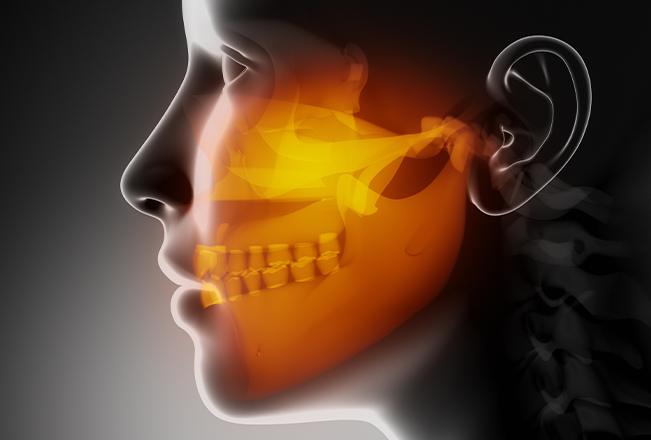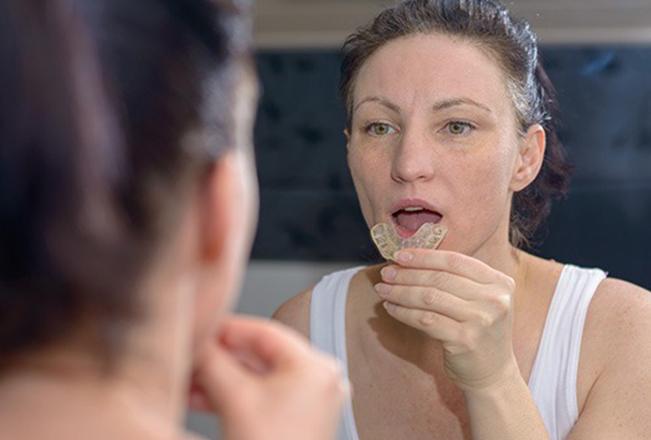If you suffer from the pain and discomfort of TMJ, Sana Dental is here to help! We are pleased to offer TMJ/TMD Therapy options to help alleviate the associated pain and discomfort, and help you attain optimal health and wellness.

Your Alberta Choice for TMJ/TMD Therapy!
What is TMJ?
The acronym for TMJ stands for two things:
- Your temporomandibular, or jaw joint
- A disorder with that very same joint
Confusing as it seems at first, TMJ is essentially a malfunctioning jaw joint.
The temporomandibular joint is the “hinge” that connects your lower jaw to your skull on either side of your head. It is responsible for the ability to open and close your mouth, as well moving your jaw from side to side. The temporomandibular joint is easy to locate – it is just in front of the middle of your ear. To locate it, move your fingers along your cheekbones until they are just in front of your ear. Now, open and close your jaw. The movement that you feel is your jaw joint; the point where your lower jaw attaches to your skull. Most of the time the TMJ works well, but there are times when problems occur with the TMJ, which causes severe pain.


A TMJ Disorder Can Be Painful!
When your jaw is out of alignment, your upper and lower teeth meet incorrectly in a “bad bite.” This is what is known as TMJ, or TMD (temporomandibular joint disorder).
With TMJ, your jaw muscles must work extra hard to do everything they need to do. When they tire, they recruit surrounding muscles – those of the head, face, neck, and shoulders. Eventually, these muscles fatigue as well, becoming strained and inflamed, putting pressure on the nerves that run through them, and sending pain signals to your brain.
Symptoms of TMJ
If stress is being placed on your jaw and surrounding muscles, you may develop certain symptoms, including:
- Headaches or migraines
- Jaw pain
- Clicking, popping or locking of your jaw
- Tingling in your fingers and back of your hand,
- Pain in your neck or shoulders
- Ear aches, congestion or ringing
- Facial pain
- Poor posture


TMJ Treatment Options Can Relieve Your Pain!
In many cases, TMJ can be treated. The first step is an accurate diagnosis. Most commonly, TMJ is diagnosed by a dentist or a physician. The exam often starts with an assessment of your face and jaw for pain or tenderness, noises made by the joint when it moves, the alignment of your bite, and how far you can open your mouth.
X-rays, CT scans, MRIs, BioPak diagnostics or TENS (Transcutaneous Electrical Nerve Stimulation) are tools that medical health practitioners may choose to help with the diagnosis. They allow the dentist or physician to see the surrounding bones, teeth and soft tissues in greater detail to determine if they have a role to play in the disorder.
TMJ Treatment Options
Once the cause of your TMJ problem has been uncovered, the next step is finding a treatment. Treatment options include:
- Physiotherapy or massage to relax the jaw muscles
- An orthotic to help your jaw move back into proper alignment
- Dental restorations such as crowns, veneers, or dental bonding to repair damaged teeth
- Dental bridges or implants to replace missing teeth
- Orthodontics to widen a too-narrow jaw or straighten crooked teeth

If you are experiencing jaw pain, accompanied by any other symptom of TMJ, Sana Dental is here to help! If you have any questions about TMJ/TMD Therapy, or you would like to learn more about possible treatment options for TMJ, call us at (780) 476-3391 and we will be happy to help!
We look forward to hearing from you soon!
Call us at (780) 476-3391 to set up your TMJ/TMD Therapy today!